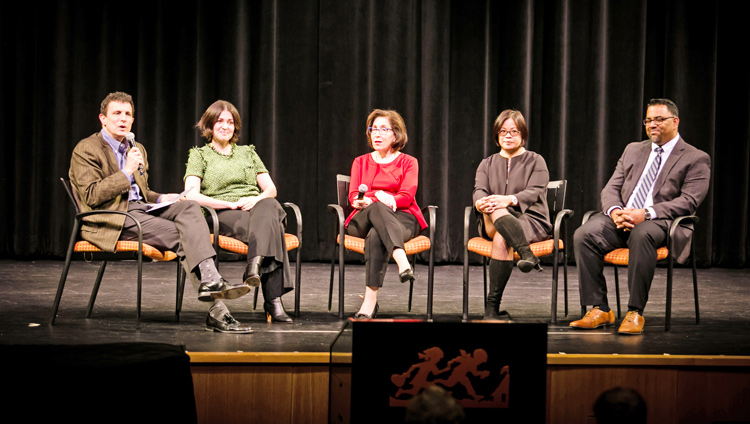

By Michelle Moskowitz
Sentinel Correspondent
What happens when autistic children grow up to be autistic adults?
David Remnick, the Pulitzer Prize-winning author of “Lenin’s Tomb” and longtime editor of The New Yorker magazine, hosted an evening exploring that delicate theme last week at the Performing Arts Center at the Greenwich Country Day School, largely for an audience whose lives have been touched by Autism Spectrum Disorder (ASD).
Remnick and his wife, Esther, themselves have a child with special needs. “Everyone knows or loves someone with autism,” Remnick said.
ASD, defined as a complex set of neurological disorders that severely impact one’s social, communicative and cognitive functions, affects one in 68 children in the United States, according to the Centers for Disease Control and Prevention (CDC).
ASDs are five times more common in boys (1 in 42) than in girls (1 in 189), and affect all racial, ethnic, and socioeconomic groups. Causes of ASD are still unknown, and researchers are still unclear as to what, if any, environmental triggers may play a role in the onset of the disorder.
Remnick, in collaboration with NEXT for AUTISM, a non-profit dedicated to building bright futures for people on the spectrum, screened the acclaimed HBO documentary “How to Dance in Ohio,” an endearing look at a group of young teenagers and adults with varied levels of ASD as they prepare for an iconic event—the prom—kick-starting their journey into adulthood.
Autism experts define this transitional period as “The Cliff”—the life-changing moment when young adults turn 21 and are no longer eligible for school programs or other ancillary programs, a daunting prospect for both kids and parents as they plan for what’s next.
NEXT is committed to helping kids on the spectrum make the transformation with as little difficulty as possible; more than a half million autistic teens are expected to transition into adulthood in the next decade.
The organization’s chief goal is to help all individuals live engaged, productive and meaningful lives in their communities through specially designed programs that help with socialization skills, as well as employment training programs that can benefit both the individual and the society-at-large.
Ilene Lainer, co-founder and president of NEXT, thanked the impressive group of attendees for coming out to show their support before introducing the Peabody Award-winning film, which premiered at the Sundance Film Festival in 2015.
“How to Dance in Ohio” is a beautifully crafted film that asks viewers to re-evaluate society’s norms through its focus on three autistic girls (Marideth, Jessica and Caroline) as they prepare for the prom and begin to look toward the next chapter in their lives—with mixed emotions and trepidation.
Alexandra Shiva, the film’s producer and director, had watched the autistic child of a close friend grow up, and became increasingly curious about what “coming of age” looked like for kids on the spectrum. Shiva noticed there was little attention paid to this poignant transitional phase; as an artist who has “always been interested in stories of people trying to belong,” she wanted to change that.
After much research, she was introduced to clinical psychologist Dr. Emilio Amigo in Columbus, Ohio. When she learned of his mission—to take his group to prom—she knew she had found her story about belonging.
“I had such great characters to film,” Shiva said with an ear-to-ear smile. “Everyone in the group was really open to filming, as they all just really wanted to connect.” She added, “I think making the film even helped with their development in some way.”
The audience travels alongside the group every step of the way; in almost a supportive role, it attends group therapy sessions, watches as one asks another for a date with bated breath, spends time in their homes navigating the family dynamics, begins to relate to the parental struggles—and admires the perseverance and heart that rises to the forefront as parents deal with a child with special needs.
One of the many touching moments has Jessica and Caroline reveling in their “glamorous fashion spree” as they try on a multitude of prom dresses with their mothers.
When each girl finds the perfect dress for the dance, the mothers look fondly at their animated, beautiful daughters staring at themselves proudly in the mirror; and at that moment, they can envision their daughters being just like everyone else.
And at that moment, they are like everyone else.
Esther Fein, a former New York Times reporter and an active board member and supporter of NEXT’s programs, said she ultimately hoped that viewers would take part in the relatable “truths” that each character represents along their journeys.
“I want people to see the humanity of these kids, that their challenges are still very great, but we can all see ourselves in these kids,” said Fein.
Throughout the film, we see Dr. Amigo pushing his students with difficult exercises that help them adapt to societal norms, but always does so with an empathetic approach.
He even shows them how to dance.

When one character admits how anxious he is about the preparation for the big night, Dr. Amigo replies, “Let’s give it up for butterflies—that means you are alive,” he says.
The build-up to the dance is intense; without giving it all way, it turns out to be a beautiful evening, culminating in tears of joy as viewers watch the blossoming of this dynamic group. It’s also a stark reminder that connecting with others is no easy feat for anyone—especially for those on the spectrum.
Another memorable moment occurs when one of the main characters, Jessica, is dancing with a friend she likes very much and says with disarming candor, “I don’t really know how to dance to this song, but I really want to dance with you.”
After the screening, Remnick moderated a panel of autism experts including Shiva; Christine Lai, an autism expert; Liane Carter, a writer and advocate; and Jerry Philip, vice-president of program development for NEXT for AUTISM.
While the panelists weighed in on the importance of equipping adolescents with the necessary tools to transform themselves into well-adjusted adults, it was the questions from the audience that bound the audience together as a close-knit group of parents hopeful for a brighter future.
Carter, whose new memoir about life with her autistic son, “Ketchup is My Favorite Vegetable: A Family Grows Up with Autism,” was just named the 2017 Outstanding Book of the Year by the American Society of Journalists and Authors. “I wanted to write the book I wish I had when he was first diagnosed,” said Carter.
When Remnick asked Christine Lai, the mother of a son with autism, what she envisions for her son in the future, she said, “The future that I envision for my son with autism is the same future that I envision for my son without autism.
“We want them to live independently, we want them to have a job or some kind of meaningful activity, we want them to have friends, we want them to have romantic interests—we want all the things that we want for our typical children for our children on the spectrum.”
What needs to be created in order to make those things happen? “Autism is considered a children’s disorder really, you see little children having therapy, but you never see that in the context of an adult living in the world, being one in the community,” Lai replied.
“The community needs to be ready for that, which is why books like Liane’s and movies like Alexandra’s and TV shows like “The Good Doctor,” are important to educate the world, the community, about what individuals with autism look like. And individuals with autism, they also need to prepare to be in the world,” said Lai.
NEXT created the first evidence-based public school dedicated exclusively to autistic children in New York. There are now two—one in Harlem and the other in the Bronx, which opened last month.
The organization also developed The Center for Autism and the Developing Brain (CADB), a state-of-the art clinical center with New York-Presbyterian Hospital, Columbia and Weill Cornell spearheaded by Dr. Catherine Lord, a leading expert in the field of autism.
Their key job training programs include:
• Project SEARCH Autism Enhancement, an employment training package available to national organizations and institutions that help young adults gain meaningful employment opportunities.
• ADVICE, a program that helps companies develop initiatives to hire, train and retain employees with autism in collaboration with Autism Speaks and the Poses Family Foundation. Companies such as Staples, Cintas, Quest Diagnostics, Meijer and NCR have hired over 104 people from the program.

The day after the event, David Remnick graciously took time to answer the Sentinel’s questions about autism, journalism, books and magazines:
GS: From your perspective, what is the single most important thing for people to understand about Autism Spectrum Disorder and its impact in our society?
DR: What I hope people understand is that individuals with autism are not “others”—they are our sisters and brothers, our neighbors and classmates, our children, our grandchildren, our friends. At NEXT for Autism we have a saying—“Someone you know loves someone with autism.” What this means is that autism affects all of us and our society and we all have a role to play in assuring that people with autism have the opportunity to lead lives filled with joy and meaning.
Instead of judging a parent trying to help a child struggling to navigate an overwhelming environment, show compassion and support. Rather than creating silos of disabilities, include people with autism in your workplaces, your recreation facilities, your communities. People with autism, even those with tremendous challenges, have so much to teach us, if we are only prepared to learn.
GS: How can journalism impact a significant change in ASD?
DR: I think journalism has a role to play with the heart and the head. In other words, before it makes an emotional subject of autism, it needs to inform people of a really complex matter. Autism is a mystery in terms of its origins and in terms of a cure, but it is important to understand how varied it is, how every case, every person, is different. The most difficult thing, of course, is also to try and understand the inner lives of these children and adults, how their emotional and intellectual worlds are deeply human, yet so different. A film like Alex Shiva’s “How to Dance in Ohio” is an example of journalism that gets to the heart and the head of these questions. It’s an amazing film on that level, and more.
GS: What advice can you offer to journalists and writers today who want to raise awareness and serve as a catalyst on important social issues such as ASD?
DR: The best advice I can give is to get out there and bear witness. Visit programs that employ people with autism. Interview parents. Interview caregivers and service providers. Talk to their siblings. Statistics tell an important part of the story. But there is no substitute for listening to people tell their own stories. And for those who cannot speak for themselves, listen to the ones who know them best.
GS: Inquiring minds want to know. What does the Pulitzer Prize-winning author, journalist and longtime editor of the country’s most honored magazine read on a daily basis (other than The New Yorker)?
DR: What do I read? Some things I read all the time: the Times, the Washington Post, websites like Slate, The New York Review of Books, various magazines, including The Atlantic, and many more. I also read a range of blogs and websites that offer me insights into different slices of society. What I try to be reading always is one or more books, fiction and nonfiction, contemporary and classics. I’m afraid the stack is unending….
GS: What three books have had a lasting impact on you and/or inspired you to become a writer?
DR: Just three books, that’s all I get? How about, for starters, a few things that I read as a teenager that really rocked my world in terms of the possibilities of non-fiction writing (since that’s what I went into): James Baldwin’s essays, Joan Didion’s “The White Album” and “Slouching Toward Bethlehem,” and Walt Whitman’s “Democratic Vistas” and “Specimen Days.” But if I were telling you the absolute truth about the first writing that really affected me imaginatively, it was the first dozen albums of Bob Dylan’s. (And many more after.) That led absolutely everywhere, it was my lexicon and inspiration, not to be a writer, but to be alive.
For more information on NEXT’s programs and services, visit NEXTforAUTISM.org
To watch “How to Dance in Ohio,” visit Hbo.com.
To read Remnick’s journalism or listen to his national radio program and podcast, The New Yorker Radio Hour, visit Newyorker.com




